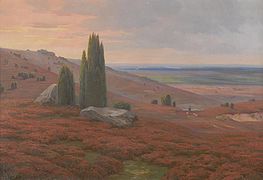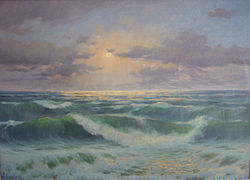Arnold Lyongrün


Ernst Arnold Lyongrün (1871–1935) was a German practitioner of the Jugendstil or Art Nouveau style of decorative arts and a painter in the Impressionistic mode.
Early life
[edit]Lyongrün was born Oct. 2, 1871, in Domnau, Province of Prussia (now Domnovo, Russia). He grew up during the Gründerzeit boom of Imperial Germany, studying in Königsberg (now Kaliningrad, Russia) and Breslau (now Wrocław, Poland). Thereafter he studied at the Académie Julian in Paris under French artists Jules Joseph Lefebvre and Tony Robert-Fleury, and undertook student journeys around France, Austria and Italy.
Beginning in 1898, Lyongrün lived and worked in the Hamburg area, and in 1907 he became a teacher at the State Academy of Art in Hamburg. During the First World War he was drafted into the Germany Army. Lyongrün survived the war and in 1919 became an independent painter. He became a member of the Hamburg Artists Society (founded 1920) and subsequently a member of the German National Association of Visual Artists (Reichsverband Bildender Künstler Deutschlands). A few years later he was a member of the artists colony at Ahrenshoop on the Darss Peninsula at the Baltic Sea, in Hither Pomerania.[1][2]
Career
[edit]During his sojourn in France, the young Lyongrün was inspired by the Art Nouveau movement exemplified by the Nancy School.[3] He published a number of patterns for decorative arts and crafts, among them Decorative Motifs from the Natural World (1899) and New Ideas for Decorative Art (1901).[4] These works are held by the Metropolitan Museum of Art, New York.
In art history, Lyongrün is regarded primarily as a landscape painter and a marine artist. His paintings include scenes from the Black Forest, the Lüneburg Heath, the low-lying environs of Hamburg and the shores of the Baltic Sea. He also painted a few portraits. Early exhibitions of Lyongrün's works were staged in Hamburg in 1911 and 1919.
Gallery
[edit]-
Spring on the Lühe (1904)
-
The Blooming Heath (1910)
-
Feldberg, Black Forest (1910)
-
The Source (1911)
-
Mill on the Titisee (1912)
-
Oaks on the Kellersee (1919)
-
Evening on the Baltic (1921)
-
Heath Landscape near Wilsede
-
Baltic Sea Surf (1925)
-
Track, Lüneburg Heath
-
Spring, Black Forest (1912)
References
[edit]- ^ Gerhard M. Schneidereit: Dunkler Wald und weites Meer – Einhundert Jahre Malerei auf dem Darß. 2010
- ^ 100 Jahre Malerei auf dem Darß. In: Ostseezeitung, 2 August 2010
- ^ École de Nancy
- ^ Arnold Lyongrün (DjVu). In: Hans W. Singer (Hrsg.): Allgemeines Künstlerlexikon. Leben und Werke der berühmtesten bildenden Künstler, Band 6. Rütten, Frankfurt am Main 1922. Internet Archive, retrieved 19 October 2010
Publications
[edit]- Arnold Lyongrün: Eine Sammlung naturalistischer Motive. Verlag Bernhard Friedrich Voigt, Leipzig 1898
- Arnold Lyongrün: Neue Ornamente. Verlag Ernst Wasmuth, Berlin 1899–1902
- Arnold Lyongrün: Vorbilder für Kunstverglasungen im Style der Neuzeit. Verlag Hessling, Berlin / New York 1900
- Arnold Lyongrün: Neue Ideen für dekorative Kunst und das Kunstgewerbe, Verlag Kanter und Mohr, Berlin 1903
- Arnold Lyongrün: Masterpieces of Art Nouveau, Stained Glass Design, 91 Motifs in full color. Verlag Dover Pubn, 1989
- Arnold Lyongrün: From Nature to Ornament, Organic Forms in the Art Nouveau Style. Dover Pictorial Archive Series, 2010
Sources
[edit]- Brockhaus' Kleines Konversations-Lexikon, Bd. 1. 5. Auflage, Leipzig 1911, S. 687.
- Hans W. Singer (Hrsg.): Allgemeines Künstlerlexikon. Leben und Werke der berühmtesten bildenden Künstler, Bd 6. Rütten & Loening Verlag, Frankfurt/M. 1922.
- Ernst Rump (ed.), Kay Rump (pub.), Maike Bruhns (pub.): Der Neue Rump. Lexikon der Bildenden Künstler Hamburgs, Altonas und der näheren Umgebung. 2. Auflage. Verlag Wachtholz, Neumünster 2005, ISBN 3-529-02792-8.
- Paul Pfisterer: Signaturlexikon. Walter de Gruyter, Berlin / New York 1999, p. 425
External links
[edit]- 1871 births
- 1935 deaths
- People from Pravdinsky District
- People from the Province of Prussia
- 19th-century German painters
- German male painters
- 20th-century German painters
- 20th-century German male artists
- Art Nouveau painters
- German Impressionist painters
- 19th-century German male artists
- Expatriates from the German Empire
- Expatriates in France











